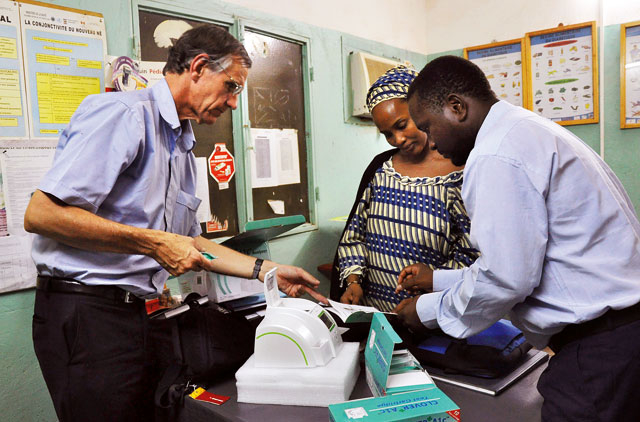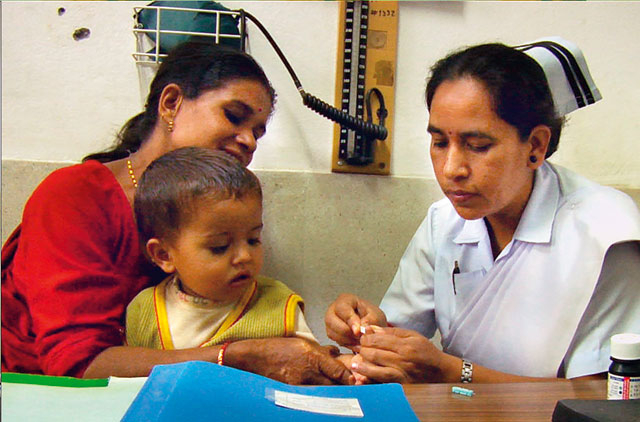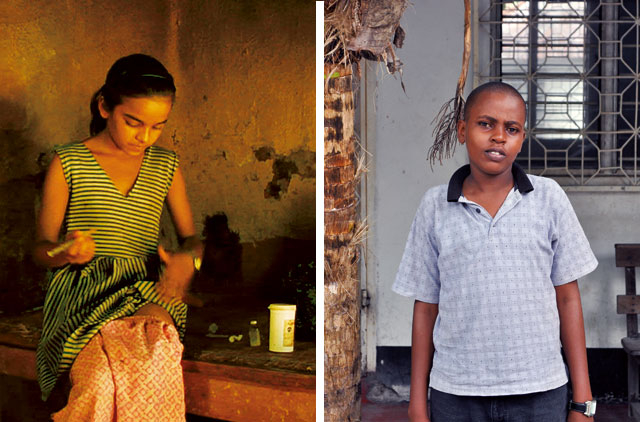
It's break time in school, but Faris Rahman is not yet ready to run out and play with his friends. Ignoring their shrieks and screams as they have fun, the six-year-old sits down at his desk. Opening his bag, he drags out everything he needs along with his book to jot down the numbers. Faris concentrates while his class teacher watches. But the little boy is not solving a maths problem or sitting an exam. He is diabetic and needs to test his blood four times a day to work out his glucose levels. Today, Faris reads the test strip after dabbing it with blood - and grins. There's no need for an injection right now, so he can join his friends playing outside.
But not all children are as fortunate as Dubai-based Faris, who was diagnosed with type 1 diabetes when he was just two. His parents spend a lot of time - and money - ensuring he is healthy, has his injections when he needs them, four times a day, and taking him for constant check-ups.
"We work hard to make sure his blood sugars are level and that he's as healthy as he can be," says his mother Huma Ehtisham. While his medical insurance covers the cost of the insulin, his parents have to bear the cost of the blood-glucose test kits among other things, which works out to around Dh500 a month.
But some children in underdeveloped countries aren't always so lucky. Like Faris, Kalpana, from Nagpur in central India, was just two years old when her parents suspected something was seriously wrong with her. Unlike his situation though, Kalpana's father was a labourer who didn't earn much. Concerned, he took her to a clinic which was run by Dr Sharad Pendsey, a diabetologist who conducted a few tests and confirmed she had type 1 diabetes - also known as juvenile diabetes, and would need daily injections of insulin.
"She was a cheerful girl and was making good progress in her condition although she had to take insulin regularly,'' remembers the doctor. "However, one day when she was five, she was brought to the clinic by her parents, comatose.'' "The blood-glucose level in her body had risen dangerously and she had gone into shock.'' The little girl died even before the doctor could have a chance to help her.
A distraught Dr Sharad spoke to her parents, only to be told that they had failed to give her insulin for the past several days simply because they couldn't afford to buy it.
"Kalpana had always come to our yearly picnics for children with type 1 diabetes. But because her parents couldn't afford to get her the daily dose of insulin that kept her alive, I realised she would never come to our picnic again,'' he says. The tragedy was the reason he and his wife Swati set up Dream Trust, a charity that cares for diabetic children globally, to help prevent further tragedies.
The Trust (www.dreamtrust.org) has so far sponsored over 500 type 1 diabetic children who are given free insulin, syringes, monitoring strips and glucometers, and their health is monitored regularly. This is just one of the scores of charities that the International Diabetes Federation's (IDF's) Life For A Child has tied up with in developing countries to take forward their dream of ensuring that no child with diabetes dies. It currently helps 45 children and adolescents in Nagpur manage their condition.
Alarming statistics
Type 1 diabetes is one of the most common life-threatening disorders in childhood around the globe, with approximately 440,000 children under the age of 15 affected, according to the IDF's resource, Diabetes Atlas. The incidence of type 1 diabetes among children is increasing at an estimated average of 3 per cent per year across the globe and around 70,000 children worldwide are expected to develop type 1 diabetes annually.
The UAE has the second highest prevalence of diabetes in the world with around 20 per cent of the UAE population affected by the condition and another 18 per cent at high risk of developing the condition, according to a report on the Dubai Health Authority's website. However, while official figures for juvenile diabetes in the UAE are not available, the estimated number of children with type 1 diabetes in the Middle East and North Africa region is around 65,000, according to the IDF.
While patients in developed countries have diabetes-management centres and good health care at hand, those in the developing world do not have access to basic diagnostic tests, insulin and other educational tools to manage their diabetes. Recognising this, the IDF, together with the Australian Diabetes Council and an international charity organisation called Hope Worldwide, in 2000 initiated the Life For A Child (LFAC) programme providing accessible medical care to poor communities of the world.
Under this project, endocrinologists and doctors liaise with the local hospitals or grassroots primary health centres in the towns and villages in less developed countries, providing them support in juvenile diabetes management. So far, the Life for a Child programme has been able to help 8,000 children suffering from type 1 diabetes in countries including Tanzania, Sri Lanka, Ethiopia, India and Bangaldesh.
A youngster's story of hope
Eguene, a 13-year-old in Tanzania, suffers from juvenile diabetes, a condition he was diagnosed with when he was four. Thanks to LFAC, he gets free insulin and diabetes education. He has also learnt to monitor his blood-sugar levels by pricking his finger, testing the blood on a test strip and taking action if required. "I've to do this at least twice a day,'' Eguene says. "But I've got used to it.''
"I spend about ten minutes a day reading about diabetes and understanding how to manage it,'' says the boy. "I also check my blood sugar and I make sure I eat healthily as advised by the care workers, take a bike to school and exercise for an hour each week. I understand my condition better now and know how to handle it. I am studying hard to be a pilot at a prestigious airline so I need to be well. "
‘No child should die'
Eguene is fortunate in that although living in a developing country, he is able to control his health condition. "One of the main objectives of the IDF is to promote the best possible care for people with diabetes all over the world,'' says Mario Fetz, director of external relations at the IDF.
"The LFAC programme offers a vital lifeline to young people with diabetes in developing countries. The objective is to ensure the best possible chance of a healthy life for them through improvements to the quality and scope of care provided locally,' Mario adds. "The programme goes from strength to strength with the number of countries and children supported constantly on the increase. The task remains immense but progress has been made in giving children and young adults with diabetes the best possible chance of a healthy life and building the knowledge base that will help combat the epidemic."
The LFAC slogan is "No child should die of diabetes", and the battle to reach out to as many children as they can, continues.
In the UAE, the Landmark group has been supporting LFAC throughout May with its unique campaign to raise funds for the cause. The cost per child for diabetes management comes to approximately $1 (Dh3.67) per day. Customers making a purchase at any of the Landmark outlets across UAE this month can add Dh5 (or multiples of five) to their final transaction which then goes to LFAC, according to Bhuvana Acharya, head of corporate communications and corporate social responsibility at Landmark.
Through this initiative Landmark hopes to raise Dh500,000 for LFAC which is targeted at help 10,000 children by the end of this year.
Connecting care providers
Dr Graham Ogle, a Sydney-based paediatric endocrinologist who has dedicated his career to fighting juvenile diabetes and is spearheading the LFAC programme as its director, says, "We plan to reach out to 37 countries by the end of this year."
Dr Graham, 52, been associated with the LFAC since its inception and says it works connecting to the grassroots primary health centres in towns and villages around developing countries.
"The LFAC essentially deals with creating awareness about type 1 diabetes and provides clinical support to children from underprivileged backgrounds across developing countries to have access to quality medical care.
He says, "We work closely with local diabetes centres or the children's hospital, which is the primary care-giver.
"Our role is to equip them with the expertise, resources, technical know-how and the framework to build a support infrastructure to provide better care for children suffering from type 1 diabetes in their city/town/village.
"LFAC does not establish its own centres but works to strengthen key existing paediatric diabetes centres and associations so that they can provide the best possible health care, given local circumstances, to all children and youths with diabetes in their respective region or country. "Local champions are one of the key components that bring success, and they assist in identifying the needs specific to their local situation/population.
"Preferential assistance is given to the most needy children in each centre. In some countries such as the Philippines, India and Ecuador, the doctors choose patients that are most in need and work towards helping them manage their condition.
"Diabetes management is a mixture of science and art. There is the aspect of managing the patient's physical condition and also their psyche and motivation levels," says Dr Graham. "With children, this becomes even more complex. They are not able to take care of themselves and this warrants a higher level of awareness and education, especially among people who are in charge of taking care of them. This prompted me to specialise in paediatric endocrinology."
Addressing specific needs
The support provided depends on local needs and the resources available to the LFAC. It includes providing patients with insulin, syringes, blood glucose meters and strips, or visual strips, plus lancets, travelling expenses to and from clinic for the poorest families, education materials for children, families and health professionals, training of health professionals, and so on.
The LFAC attempts to reach out to as many centres in a country as it can. However, that in itself is a challenge. Dr Graham explains, "In vast countries such as India, we have limited reach and there is a need to support many more centres.
"On the other hand, we also have a presence in countries such as Azerbaijan and Ethiopia where the local partner that we have engaged actually has access to all the children that are suffering from type 1 diabetes. So we are focused on providing support and care to as many children as we can.''
Management and care
There are several layers to diabetes management and in every case, the level of complexity differs. The LFAC starts with providing insulin, and monitoring levels of insulin. Diabetes management comprises striking a delicate balance between managing insulin, diet and exercise. "Part of our responsibility is also educating the doctors, care-givers and families about how to manage a child with type 1 diabetes. So we try to cater to all the requirements of the organisations managing the support infrastructure for type 1 diabetes in the countries where we have a presence. It's a challenge, but worth the trouble," Dr Graham says. "We usually look for a local champion, who belongs to the country and is managing grass-root-level support for children suffering from type 1 diabetes. We have always had the opportunity to work with very passionate individuals and it is great to be able to empower them. Through a structured approach, they are able to make a much more significant impact. We often come in contact with families who are very receptive and it inspires us to do even better."
The organisation is already set to move into three new countries - Mexico, Iraq and Kurdistan. "The scope of what needs to be done is vast. Diabetes management is complex. While the first step is getting access to insulin, it needs to be followed up with education about diabetes management, extending sustained care and also improving the quality of care extended. I see myself trying to contribute to this field for a long time to come," he says.
This will surely help prevent more casualties like Kalpana.
What is Type I Diabetes?
Type 1 diabetes (which is also known as insulin-dependent diabetes or juvenile diabetes) occurs when the immune system of the body destroys certain cells in the pancreas that produce insulin, a hormone that helps the body move the glucose contained in food into cells throughout the body, which use it for energy.
When no insulin can be produced, the glucose remains in the blood where it can cause serious damage to the organs.
It is for this reason that people with type 1 diabetes take insulin either through multiple injections daily, or by having it delivered through an insulin pump. They would also need to test their blood sugar levels six or more times a day to ensure that is within safe limits. People with diabetes must also carefully balance their food intake and their exercise to regulate their blood sugar levels, to avoid hypoglycemic (low blood sugar) and hyperglycemic (high blood sugar) reactions, which can be life threatening.
The warning signs of type 1 diabetes include extreme thirst; frequent urination; drowsiness or lethargy; sugar in urine; sudden vision changes; increased appetite; sudden weight loss; fruity or sweet odour on breath; heavy, labored breathing; stupor; and unconsciousness.
Landmark group takes up a challenge for May: What you can do to help?
LFAC welcomes any support in spreading awareness about Type 1 Diabetes. In the UAE, the Landmark group is supporting LFAC throughout the May with its unique campaign to raise funds for the cause. Customers making any purchase at any of the Landmark outlets across UAE can add a Dh 5 (or multiples of five) to their final transaction which will then go to LFAC. Landmark plans to raise Dh 500,000 through May for LFAC. Bhuvana Acharya, head of corporate communications and CSR at Landmark elaborates: "With a mission to highlight the growing incidence of diabetes amongst children, Landmark Group has partnered with IDF's ‘Life for a Child' (LFAC) programme. The LFAC programme supports diabetes centres in developing countries such as Zimbabwe, Bangladesh, Sudan and the Philippines in providing essential clinical care, medical supplies, and education for children with diabetes.
Our main objective through this initiative is to generate greater awareness about diabetes. The Landmark Group aims to raise funds through its diverse portfolio of retail and hospitality brands, in a month long fund raising activity across its outlets in the UAE."
Dhs 5 would be able to support the entire spectrum of diabetes management for an underprivileged child for a day, including insulin/medication, tests and diabetes awareness/education.
Support group in Dubai
I am Number One, a support group for those suffering from juvenile diabetes, was started by a group of Dubai-based mothers of children suffering with type I diabetes in 2001. It is a volunteer group with no funding. "Our goals are to promote awareness of the group through schools, clinics, word of mouth; to listen to and discuss personal experiences regarding type 1 diabetes; invite dieticians, endocrinologists, nutritionists and diabetic educators as speakers; invite representatives from companies to discuss and explain products and learn about and promote healthy eating habits, among others,'' says Evelyn Matafanov, one of its main founders. Her two children, Michael, 15, and Ksenia, 18, have the condition.
"Our aim is to offer support in the absence of family and hopefully achieve, by way of personal experiences, a greater understanding of the condition and daily management,'' she says.
See www.iamnumberone.org.
First person: ‘My little boy needs four injections a day'
Dubai-based Huma Ehtisham, Faris's mother, says he was diagnosed with type I diabetes when he was just two. "I was very fortunate that the nursery that Faris went to had a nurse who had worked with type I diabetes kids and was immediately able to pick out the symptoms, which include extreme thirst, frequent urination and drowsiness or lethargy, among others.'' Juvenile diabetes occurs when the immune system of the body destroys certain cells in the pancreas that produce insulin, a hormone that helps the body move the glucose contained in food into cells throughout the body, which use it for energy.
The nurses and teachers of the Jebel Ali Primary School where Faris is a student now and Dr Amel Bushra Al Tayeb, consultant endocrinologist at the Diabetes and Endocrinology Centre in Dubai Healthcare City also offered enormous help, she says.
Faris too has learnt to check his blood glucose levels. "He began doing it when he was five and always does it in the presence of an adult. But learning about how many units of glucose he will need and how to count his carbohydrates is a big learning curve," she says. As of now Faris requires four injections of insulin daily. Huma does this in the morning when Faris goes to school and the effect lasts until he has had a breakfast and a light snack. When he returns home by lunch, it is time for his next injection. The third is when he is going out to play and the last at night.
"Type I diabetes costs are high and although our insurance covers the cost of the insulin it does not cover things like testing strips,'' she says. "Faris uses up to ten to 12 strips per day to monitor his glucose. The diabetes pump that is available here costs Dh20,000, but I was more interested in the new age insulin monitors as it has no wires and insulin is administered by a remote control device. It's still not available here though."














